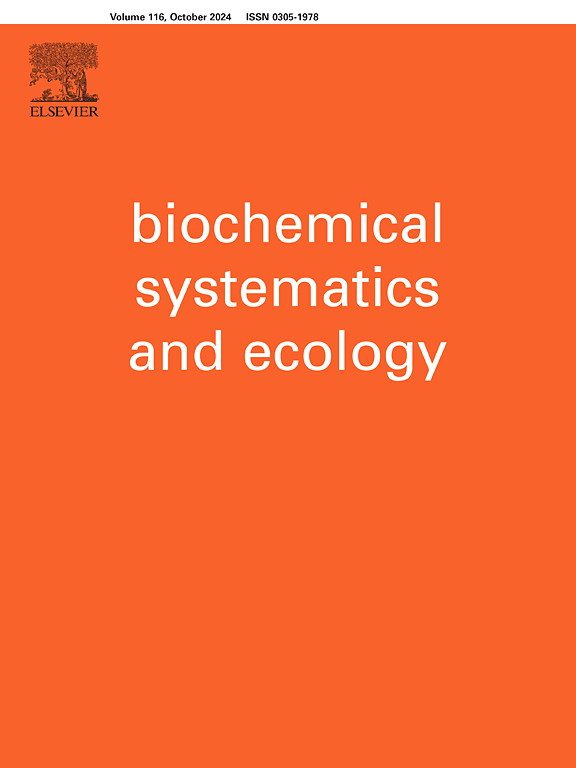Flavonoids and volatile compounds of Cercis siliquastrum (Fabaceae, Cercideae)
IF 1.4
4区 生物学
Q4 BIOCHEMISTRY & MOLECULAR BIOLOGY
引用次数: 0
Abstract
This study provides a comprehensive analysis of the flavonoid and volatile compound profiles of leaves, bark, and flowers of Cercis siliquastrum L. Flavonoids were separated via chromatographic techniques and identified using NMR spectrometry and MS, while volatile compounds were analyzed by headspace GC-MS. A total of eight flavonoids (catechin, epicatechin 3-O-gallate, epigallocatechin 3-O-gallate, dihydromyricetin 3-O-rhamnoside, kaempferol 3-O-rhamnoside, quercetin 3-O-rhamnoside, myricetin 3-O-rhamnoside, and myricetin 3-O-glucoside), and 27 volatile compounds were identified. Myricetin 3-O-rhamnoside was detected in a high concentration in C. siliquastrum leaves and flowers, while catechin was predominantly found in the bark. Considering the GC-MS results, aldehydes dominated in C. siliquastrum leaves and flowers, and monoterpenes were the most abundant volatile compounds in the bark. Additionally, an analytical system for flavonoid analysis in C. siliquastrum was established, and the chemophenetic significance of flavonoids in the genus Cercis was discussed.

茜草科茜草科茜草黄酮类化合物及其挥发性成分
本文对茜茜叶、树皮和花的黄酮类化合物和挥发物进行了综合分析。黄酮类化合物通过色谱技术分离,采用核磁共振光谱法和质谱法进行鉴定,挥发物采用顶空气相色谱-质谱法进行分析。共鉴定出8种黄酮类化合物(儿茶素、表儿茶素3- o没食子儿茶素3- o没食子酸酯、二氢杨梅素3- o鼠李糖苷、山奈酚3- o鼠李糖苷、槲皮素3- o鼠李糖苷、杨梅素3- o鼠李糖苷和杨梅素3- o葡萄糖苷)和27种挥发性化合物。杨梅素3- 0 -鼠李糖苷在金合欢叶和花中含量较高,儿茶素主要存在于树皮中。气相色谱-质谱分析结果表明,金合欢叶和花的挥发性成分以醛类化合物为主,单萜化合物含量最高。建立了鸢尾黄酮分析体系,探讨了鸢尾黄酮在鸢尾属植物中的化学意义。
本文章由计算机程序翻译,如有差异,请以英文原文为准。
求助全文
约1分钟内获得全文
求助全文
来源期刊

Biochemical Systematics and Ecology
生物-进化生物学
CiteScore
3.00
自引率
12.50%
发文量
147
审稿时长
43 days
期刊介绍:
Biochemical Systematics and Ecology is devoted to the publication of original papers and reviews, both submitted and invited, in two subject areas: I) the application of biochemistry to problems relating to systematic biology of organisms (biochemical systematics); II) the role of biochemistry in interactions between organisms or between an organism and its environment (biochemical ecology).
In the Biochemical Systematics subject area, comparative studies of the distribution of (secondary) metabolites within a wider taxon (e.g. genus or family) are welcome. Comparative studies, encompassing multiple accessions of each of the taxa within their distribution are particularly encouraged. Welcome are also studies combining classical chemosystematic studies (such as comparative HPLC-MS or GC-MS investigations) with (macro-) molecular phylogenetic studies. Studies that involve the comparative use of compounds to help differentiate among species such as adulterants or substitutes that illustrate the applied use of chemosystematics are welcome. In contrast, studies solely employing macromolecular phylogenetic techniques (gene sequences, RAPD studies etc.) will be considered out of scope. Discouraged are manuscripts that report known or new compounds from a single source taxon without addressing a systematic hypothesis. Also considered out of scope are studies using outdated and hard to reproduce macromolecular techniques such as RAPDs in combination with standard chemosystematic techniques such as GC-FID and GC-MS.
 求助内容:
求助内容: 应助结果提醒方式:
应助结果提醒方式:


